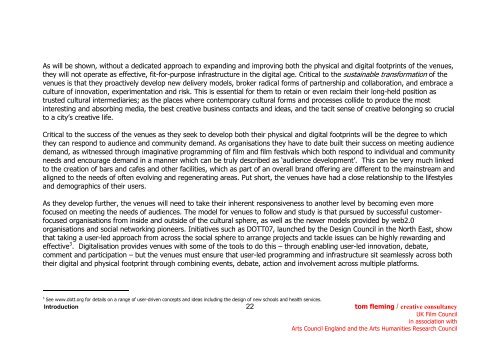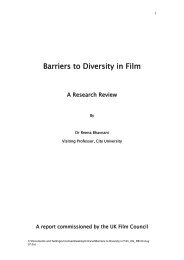Crossing Boundaries - BFI - British Film Institute
Crossing Boundaries - BFI - British Film Institute
Crossing Boundaries - BFI - British Film Institute
You also want an ePaper? Increase the reach of your titles
YUMPU automatically turns print PDFs into web optimized ePapers that Google loves.
As will be shown, without a dedicated approach to expanding and improving both the physical and digital footprints of the venues,<br />
they will not operate as effective, fit-for-purpose infrastructure in the digital age. Critical to the sustainable transformation of the<br />
venues is that they proactively develop new delivery models, broker radical forms of partnership and collaboration, and embrace a<br />
culture of innovation, experimentation and risk. This is essential for them to retain or even reclaim their long-held position as<br />
trusted cultural intermediaries; as the places where contemporary cultural forms and processes collide to produce the most<br />
interesting and absorbing media, the best creative business contacts and ideas, and the tacit sense of creative belonging so crucial<br />
to a city’s creative life.<br />
Critical to the success of the venues as they seek to develop both their physical and digital footprints will be the degree to which<br />
they can respond to audience and community demand. As organisations they have to date built their success on meeting audience<br />
demand, as witnessed through imaginative programming of film and film festivals which both respond to individual and community<br />
needs and encourage demand in a manner which can be truly described as ‘audience development’. This can be very much linked<br />
to the creation of bars and cafes and other facilities, which as part of an overall brand offering are different to the mainstream and<br />
aligned to the needs of often evolving and regenerating areas. Put short, the venues have had a close relationship to the lifestyles<br />
and demographics of their users.<br />
As they develop further, the venues will need to take their inherent responsiveness to another level by becoming even more<br />
focused on meeting the needs of audiences. The model for venues to follow and study is that pursued by successful customerfocused<br />
organisations from inside and outside of the cultural sphere, as well as the newer models provided by web2.0<br />
organisations and social networking pioneers. Initiatives such as DOTT07, launched by the Design Council in the North East, show<br />
that taking a user-led approach from across the social sphere to arrange projects and tackle issues can be highly rewarding and<br />
effective 3 . Digitalisation provides venues with some of the tools to do this – through enabling user-led innovation, debate,<br />
comment and participation – but the venues must ensure that user-led programming and infrastructure sit seamlessly across both<br />
their digital and physical footprint through combining events, debate, action and involvement across multiple platforms.<br />
3 See www.dott.org for details on a range of user-driven concepts and ideas including the design of new schools and health services.<br />
Introduction 22<br />
tom fleming / creative consultancy<br />
UK <strong>Film</strong> Council<br />
in association with<br />
Arts Council England and the Arts Humanities Research Council

















